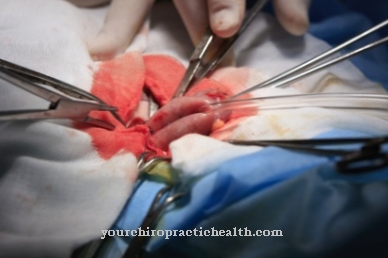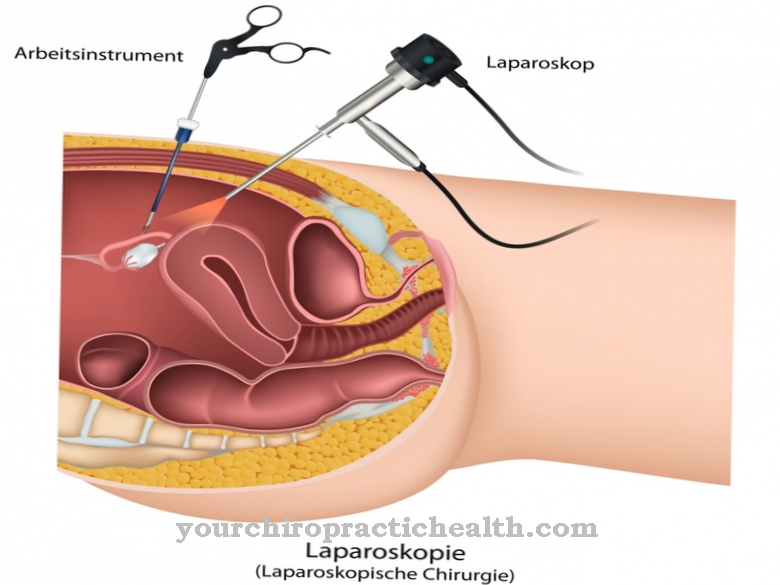In the Callus distraction a bone is severed and its length is increased by means of an implanted system. This therapy can be useful, for example, in the case of clinically relevant side differences of limbs that lead to a malalignment. The risk of infection has hardly existed since the fully implanted systems.
What is callus distraction?

The callus distraction is also called Callotasis designated. The expression of Distraction Osteogenesis. The procedure is a treatment procedure in orthopedics and maxillofacial surgery that artificially elongates a skeletal bone.
The orthopedic surgeon cuts the affected bone. The two halves of the bone are reattached using a conventional external fixation or an intramedullary nail. Over a period of several weeks, the severed bone is slowly stretched apart along the predetermined growth axis. The procedure got its name from the callus. This is fresh bone that forms on the growth axis during the procedure. The extended bone grows together in its new position as soon as the distraction comes to a permanent standstill.
Function, effect & goals
In most cases the long bones are an indication for callus distraction. With the intervention, orthopedics can correct pathological malpositions such as a functionally relevant difference in leg length. In addition, the callus distraction is used as a cosmetic operation and then has no medical indication.
For the first time, Hopkins and Penrose extended a bone intraoperatively in 1889. The procedure then involved the introduction of bone blocks. Around 20 years later, Alessandro Codivilla performed a purely surgical technique for lengthening bones on the lower extremities. The surgical techniques of the time were associated with a clear rate of complications. As expected, complications occurred in the healing phase. The most common complications are infection. These infections mainly affected the entry point of the fixator. The pain caused by the operation was high at the time. The same was true for irritation of the nerves and surrounding soft tissues.
In many cases the bone could not be lengthened sufficiently in the end. The Russian orthopedic surgeon Gawriil Abramowitsch Ilisarow realized the bone lengthening for the first time with a major breakthrough. The method used was based on bone biology. He recognized the ability of the soft tissues around the bone to regenerate under any tensile stress. To apply his procedure, he used an external fixator, also known as the Ilizarov ring fixator. Both the incidence and the severity of complications decreased thanks to Ilizarov's technique.
Today's callus distraction systems are still based on the ability of the surrounding tissue to regenerate under tensile stress. Fully implantable systems are now available for callus distraction that almost completely eliminate the risk of infections. In the phase of distraction there is no connection between the system, the skin and the outside world. This means that only the operation itself can be associated with the risk of infection, which primarily focuses on the implantation of the intramedullary nail.
The systems used are equipped with a motor that allows a daily distraction of the severed bone by around 1 millimeter after the operation. In addition to the energy supply, the systems are also controlled externally. The patient can take care of the distraction himself and is exposed to much less stress than 100 years ago. Physiotherapy is already taking place during the distraction. This physiotherapeutic accompaniment can be expected to achieve faster treatment results.
Risks, side effects & dangers
Like any surgery, callus distraction has risks and side effects. In addition to bleeding, the general operational risks include infections. Infections with callus distractions are hard to find today.
However, such infections can certainly occur in individual cases, especially when the intramedullary nail is im- and explant. The operation should be performed in an orthopedic center where doctors are fully familiar with the procedure and any risks involved in the operation. This way, the risk of complications can be minimized. Infections can result in necrosis of the tissue, which in extreme cases leads to sepsis. To prevent sepsis, the necrotic tissue usually has to be removed.
In the case of callus distraction, this can possibly correspond to an amputation of the affected limb. If there is no bleeding or infection during the operation, the risk of later complications is negligible. Pain can occur both postoperatively and during gradual distraction. The patient is usually given analgesic medication for this pain. Bruises are also conceivable postoperatively. However, these manifestations of the operation subside after a week at the latest.
In individual cases the motor of the system used may be faulty. Although such incidents are not known from the past, all technology can be subject to production errors and thus lose its functionality. If this is the case, the distraction cannot be performed despite the operation. Either the system is replaced by a functioning system in a second operation or the bone grows back together as usual. In the healing phase, the position of the bone fragments has to be right.
If the position of the bone parts slips, the bone can still grow together, but the patient then suffers from a misalignment. Physiotherapeutic measures should be started as early as possible to rule out muscle atrophy.

























.jpg)

.jpg)
